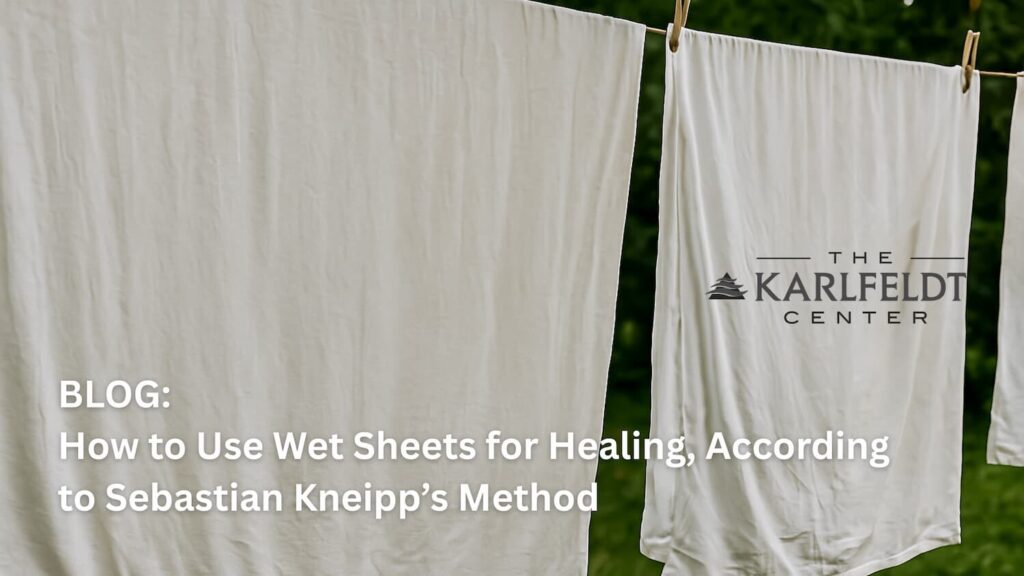
Sebastian Kneipp, a renowned naturopathic healer, pioneered the use of water-based therapies to treat various ailments and restore overall well-being. One of his key methods was the application of wet sheets to the body. This simple yet effective technique is designed to help the body dissolve toxins, evacuate impurities, and strengthen the organism as a whole. Wet sheets can be used to enhance circulation, calm inflammation, and stimulate the body’s natural healing processes.
In this article, we’ll guide you through how to use wet sheets, explain their therapeutic effects, and offer practical tips for incorporating them into your wellness routine.
What Are Wet Sheet Applications?
Wet sheets are a type of hydrotherapy where large, dampened cloths are wrapped around the body. The application works by using the body’s natural heat to gradually warm the cold or cool sheet, stimulating circulation and gently detoxifying the body. Kneipp’s philosophy emphasized the dissolving of toxins, the evacuation of impurities through sweating, and the overall strengthening of the body’s defenses. Wet sheet treatments align with these goals, offering a natural method for helping the body return to balance.
Benefits of Wet Sheet Applications
- Detoxification: Wet sheets encourage sweating, which helps eliminate toxins from the body through the skin.
- Improved Circulation: The cold sheet initially causes blood vessels to constrict, but as the body warms the sheet, blood vessels dilate, improving blood flow throughout the body.
- Calming Inflammation: Wet sheets can reduce localized or systemic inflammation by drawing heat from the body and soothing irritated tissues.
- Strengthening Immunity: Regular use of wet sheets helps the body build resilience by gently challenging its regulatory systems, thus boosting overall immunity.
How to Perform a Wet Sheet Treatment
1. Prepare Your Materials
- A large, coarse linen or hemp sheet (preferably not fine linen as coarse material works better).
- A second dry sheet or blanket for covering.
- A bed or comfortable surface where you can lie down during the treatment.
- Optional: A feather bed or wool blanket for added warmth during colder weather.
2. Wet and Wring the Sheet
- Soak the sheet in cold water, which is typically the preferred temperature. However, for beginners or those sensitive to cold, lukewarm water can be used.
- Wring out the sheet so that it’s damp but not dripping.
3. Application of the Wet Sheet
- Lie down on your back on a bed or flat surface.
- Have someone else (or yourself, if possible) wrap the damp sheet around your body. The sheet should cover your body completely, except for your head.
- The wet sheet should be snug but not too tight. Make sure the entire body is in contact with the wet sheet for maximum benefit.
4. Cover with a Dry Sheet or Blanket
- Once wrapped in the wet sheet, cover yourself with a dry blanket or wool covering to preserve body heat. Kneipp recommended wool blankets for covering, as they help retain warmth and intensify the treatment.
5. Relax and Rest
- Stay wrapped in the wet sheet for 30 to 60 minutes, depending on your comfort level and the goal of the treatment.
- As you rest, your body will begin to warm the sheet. You’ll likely experience increased warmth and, in some cases, sweating. This process helps the body detoxify and strengthens circulation.
6. After the Treatment
- Once the treatment is complete, remove the wet sheet.
- Do not dry yourself with a towel; instead, allow your body to air dry or dress immediately in dry clothes. Kneipp believed that wiping the body disrupts the natural distribution of warmth, so skipping this step helps the body regulate heat more effectively.
- Engage in light physical activity, such as walking, to restore natural body warmth after the application. This step is essential for maximizing the treatment’s effects.
Different Types of Wet Sheet Applications
Full-Body Wet Sheet Wrap
- This is the most common method, where the entire body (except the head) is wrapped in a wet sheet. It’s ideal for detoxification and full-body circulation improvement.
Partial Wet Sheet Wrap
- For targeted areas, such as legs or arms, you can apply a wet sheet to just those parts of the body. This is useful for localized inflammation or circulatory issues.
Cooling Wet Sheet Wrap
- For those with a fever or inflammation, a cooling wrap can help draw heat out of the body and reduce fever symptoms. The sheet is applied cold, and the treatment lasts until the sheet begins to warm from body heat.
Key Considerations for Wet Sheet Treatments
- Timing: The duration of the treatment can range from 30 to 60 minutes, depending on individual tolerance and the goal of the therapy.
- Exercise Afterward: Kneipp emphasized the importance of light exercise after the wet sheet treatment to help restore normal body warmth.
- Comfort: The treatment should be comfortable, not overwhelming. Beginners may want to start with shorter sessions or use lukewarm water before progressing to cold applications.
- Hydration: Drink plenty of water before and after the treatment to support detoxification.
Who Can Benefit from Wet Sheet Treatments?
Wet sheet treatments can be beneficial for anyone looking to improve circulation, reduce inflammation, or boost the immune system. They are particularly useful for individuals with conditions such as:
- Poor circulation
- Chronic inflammation or joint pain
- Skin issues (eczema, psoriasis)
- Mild fevers or infections
However, individuals with serious cardiovascular conditions or those who are very frail should consult a healthcare professional before starting hydrotherapy treatments.
Conclusion
Sebastian Kneipp’s wet sheet application is a simple, natural way to support your body’s healing processes. Whether you’re seeking to detoxify, improve circulation, or calm inflammation, this traditional method offers a powerful tool for enhancing well-being. By incorporating wet sheet treatments into your wellness routine, you can experience firsthand the healing power of water that Kneipp championed so many years ago.
